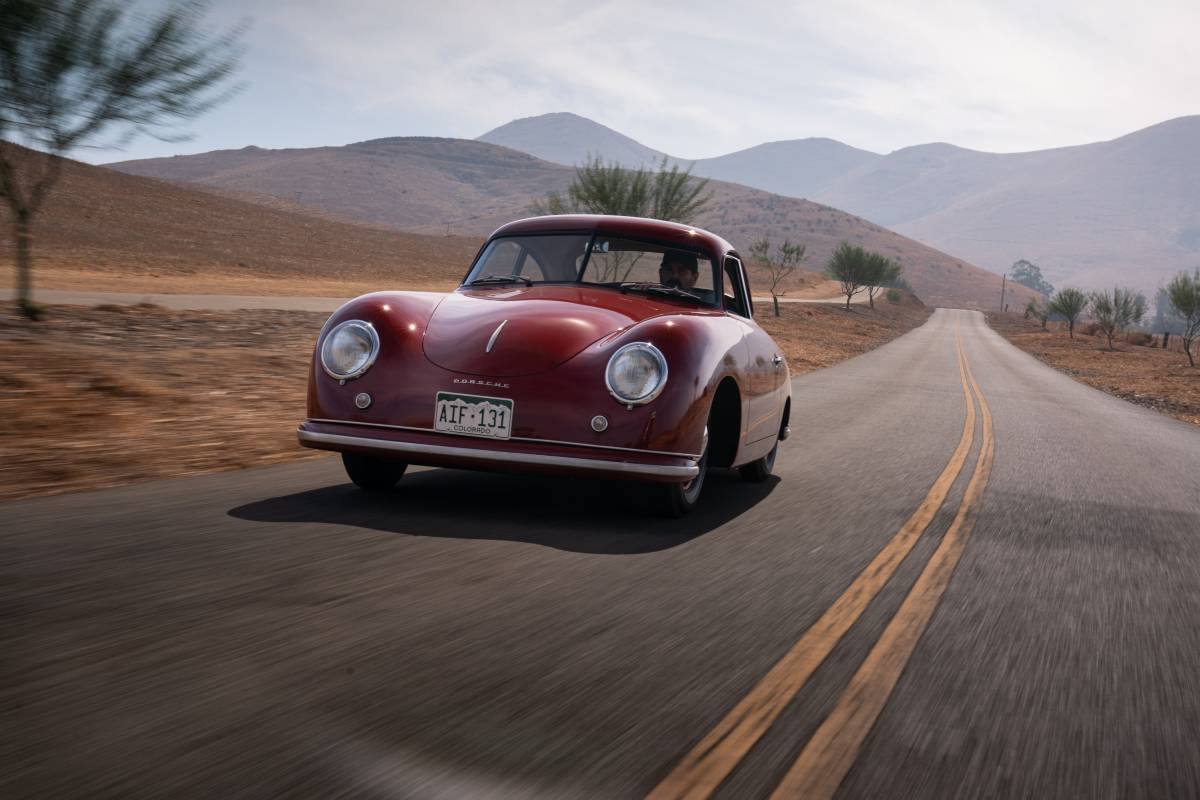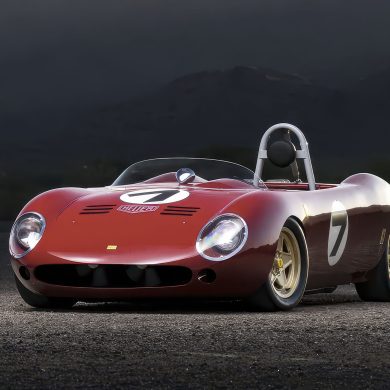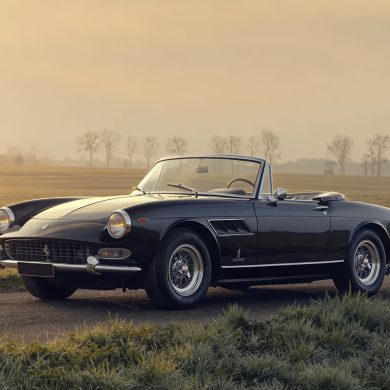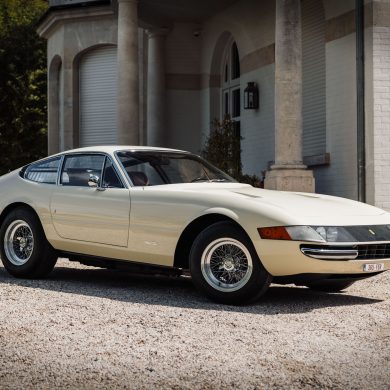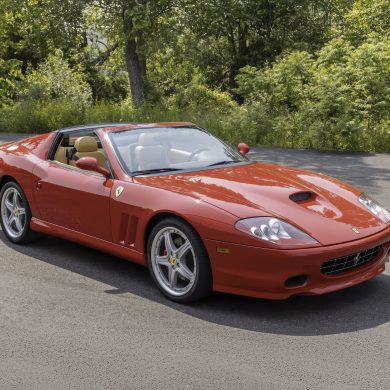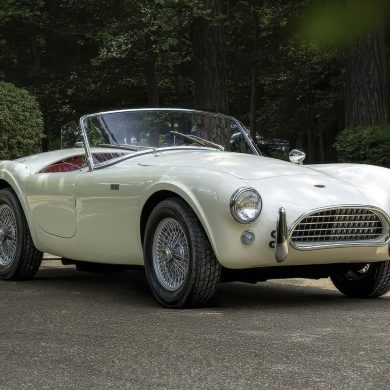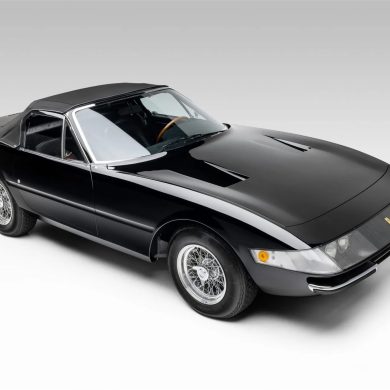On November 11-20, RM Sotheby’s held its Online Only: Open Roads, Fall auction, and cleared over $5M in sales with a clearance rate of 89%. The online auction saw over 3800 bids being placed from over 33 countries with the auction consisting of 77 distinct motor cars and almost 300 lots of memorabilia.

Courtney Frisk ©2020 Courtesy of RM Auctions
The top five sales of the RM Sotheby’s Online Only: Open Roads, Fall Auction were as follows:
| Lot 2053 | 1969 Ferrari 365 GTC | $660,000 |
| Lot 2043 | 2005 Ford GT | $522,500 |
| Lot 2033 | 1951 Porsche 356 Coupe | $330,000 |
| Lot 2068 | 2005 Ford GT | $291,500 |
| Lot 2022 | 1931 Mercedes-Benz 370 S Mannheim Sport Cabriolet | $286,000 |
Top 3 Sale Highlights
1969 Ferrari 365 GTC by Pininfarina – Lot# 2053
Sold for $660,000

The 365 GTC’s steel body was designed and constructed by Pininfarina. It fused together the general design of the 330 GTC and the 275 GTS with that of a nose similar to the one on the 400 Superamerica and 500 Superfast.
The wheelbase was kept at 94.5 inches, and they reproduced the Kamm-like ducktail rear-end. What set it apart was that the engine compartment had hood slats and not fender louvers, as seen on the 330 GTS.

The defining factor though was under the hood with the 365 GTC having a 320-horsepower, 4.4-liter Colombo V-12 engine, similar to the one on the 365 GT 2+2 that was launched in 1967 at the Paris Auto Salon. It had a single-overhead camshaft, three Weber carburetors, and two valves per cylinder. The engine was able to provide more low-end torque and stronger acceleration while maintaining the excellent road manners of the 330 GTC.

The block was somewhat longer, with wider bore spacing and bigger bores, and was also deeper so that it could accommodate a longer stroke. This resulted in an additional 20 hp gain to a total of 320 hp, and also an increase to 267 foot-pounds of torque.

In the May 29, 1969 issue of Autocar, the car was published with the following specs:
- 0 to 60 mph in 6.3 seconds
- quarter-mile time of 14.5 seconds at 99.0mph.
- Top speed of 151 mph
Production was limited to just 150 units of the 365 GTC, with a possibility that the low numbers were affected by the time of its launch in 1968- coinciding with the release of the high-profile 365 GTB/4 Daytona. The low numbers produced, however, simply added to the exclusivity and desirability of the 365 GTC amongst collectors.

The example sold, chassis number 12141, was completed on January 31, 1969, and was then delivered to the official Ferrari dealer in Bologna, Motor S.a.s. di Carla Allegretti e C, by the end of February.
It was the 49th 365 GTC that was produced and was road registered by the original owner, Paolo Pisa under “BO 369249” in Bologna. During his years of ownership, it was regularly serviced and maintained by the Ferrari factory, Assistenza Clienti in Modena.

In 2009, the renowned Automotive Restorations Inc. of Stratford provided restoration work, including totally dismantling the car, exquisitely restoring and refinishing all of its components, and accurately reupholstering and re-carpeting the inside to the period-correct shade of Pelle Biege.
In 2015, under new ownership, the car was sent to the highly reputable Ferrari mechanics at Garuti Giuseppe to perform an extensive overhaul of the engine and gearbox. In addition, works were commenced to fit the chassis with period-correct replacement headlamps.
2005 Ford GT -Lot# 2043
Sold for $522,500

In 2002 at the North American International Auto Show in Detroit, Michigan, the Vice President of Design at Ford called the GT40 a living legend. He equated the car as the greatest sports car in the world with an unmatched heritage.
Such was the roaring endorsement from the press and public alike that Ford’s CEO, William Clay Ford Jr., chose to give a limited production version the go-ahead. In addition, he wanted the first production versions to be ready for the Ford Motor Company’s centennial celebrations which were to be held in 16 months.

To make it possible, John Coletti, the Director of the Special Vehicles Team at Ford took the GT40 concept and made it street legal. One of the first and greatest challenges that they faced was how they could construct a production version that could bravely live up to the legacy of the GT40.
They did not back down from the challenge, however, as they created a dream team of designers and engineers, equipped them with the latest, state-of-the-art CAD technology, and were able to reach their targets within 3 months.

Three Ford GT was driven onto the Dearborn Centennial stage by three sporting champions of Ford motorsport. Three-time Formula 1 World Champion Jackie Stewart was the one who drove the first car on stage, with John Coletti as his passenger. The second car was driven by Ford’s Chief Operating Officer Nick Sheele and with him was 1967 Le Mans 24 Hours co-winner Dan Gurney (with A.J. Foyt). The third and final car was driven by Vice-President of Ford’s Advance Product Creation Chris Theodore, and riding shotgun with him was none other than Carroll Shelby himself.
As a testament to the incredible turnaround that the Ford Motor Company was able to accomplish in the next several years, the SVT team met their production goals, and the first GT examples were produced by 2003. It was in the spring of 2004 that full production began with the company setting a limit of no more than 4,500 cars to be produced.

The assembly of the GT started at Mayflower Vehicle Systems in Norwalk, Ohio, where it was then transferred for paint application at their facility in Tory, Michigan to Saleen Automotive, Inc.
Romeo Engine Plant, which was owned by Ford, built the engines for the GT. The SVT team that were based at Ford’s Wixom, Michigan plant was responsible for the final assembly which included the installation of the transmission, engine, and final interior fitments.

Although the first examples of the GTs were already delivered to their owners starting around August 2004, all the GTs that were produced were given a 2005 or 2006 model designation. Chassis number 10 was the first Ford GT that was made available to the general public and was sold directly to its new owner by the Ford Motor Company through a charity auction.
The other early examples were offered only to a very select clientele, and such was the privilege to be offered these early examples that the client was even required to sign a purchase agreement. The purchase agreement had a clause wherein the owner would have to keep the car for a minimum of 24 months, during the given time, Ford had the right of first refusal to buy the car back.

Following a long-kept tradition of the first examples being offered to Ford family members and specific executives, it is not a surprise that Chassis numbers 01 to 09 were immediately reserved by Ford for “internal use.”
Mr. Michael Dingman, the GTs original owner of the 2005 Ford GT Chassis #02 that was auctioned, worked on the Board of Directors for the Ford Motor Company for over 20 years and helped Ford through some of the most challenging periods in its life. In recognition of his service and commitment, he was given the chance to obtain one of these limited reserve vehicles.

On the order form posted to Mr. Dingman on May 18, 2004, a handwritten notation in the offering letter expresses “car #2.” It is speculated that chassis #01 is held directly by Ford, making chassis number 02 the lowest-numbered example of a Ford GT that is available to the public.
The GT is finished in Mark II Black with the special livery drawing from Ford’s motorsport heritage that pays tribute to the 1966 24 Hours of Le Mans-winning GT40 Mark II that was raced by Chris Amon and Bruce McLaren.

The car came decorated with painted racing stripes, lightweight BBS aluminum wheels that are fitted with Goodyear Eagle F1 tires, black-painted brake calipers, and a Sound System by McIntosh Audiophile.
1951 Porsche 356 Coupe by Reutter- Lot# 2033
Sold for $330,000

This 1951 Porsche 356 coupe was part of the second order that Korresserie Reutter, their manufacturing partner, delivered to Porsche. It was delivered with a Type 506 1,300 cubic centimeter, 4-cylinder engine (number 20025) and equipped with a 32mm Solex single-throat carburetors, providing an output of 44bhp.
Typical with the early cars, the motor of the example was replaced with something that had more power, with number 20776 with castings from 1952.

Vintage VW Restorations based in Riverside, California, rebuilt motor 20776 with a 40 PBIC carburetors and proper cylinders.A plain-bearing assembly replaced the Hirth roller bearing assembly to improve reliability.
Original to the car are the heater boxes, distributor, and tin. The original Volkswagen-derived, non-synchronized “crashbox” four-speed manual transmission, as well as the Volkswagen aluminum, finned drum brakes are also true to the original.

According to the factory Kardex which was included in the sale, the example was delivered on April 24, 1951 in 503 Maroon over a Grey cloth interior (3403) finish. It was handed over to Porsche’s franchise in Köln-Ehrenfeld, Jacob Fleishauer.
The example eventually made its way to the US, most probably through a returning serviceman, and ended up in the hands of a Seattle auto dealer, Tad Davies. It seems like there were times that Mr. Davies took the 356 to the track where it took some minor damage to the front fenders as well as the rear body panel. In the pursuit to increase the power of the vehicle, he also dismantled the engine. Then in 1960, Mr. Davies purchased a used 550 Spyder and the 356 was put to the side and kept in storage, with the engine still disassembled.

In 2011, the consignor acquired the car and commenced a restoration project that would last for more than three years.
Once the shell was stripped to bare metal, the whole front clip was taken off and an inner panel unique to the car was replaced with a panel taken from another split-window. They welded a new battery box in place. According to the consigner, the numbered hood, doors, rear bumper, and engine lid are all original. Trevor’s Hammerworks provided a reproduction front bumper. There were a few dents on the floors, but they were rust-free, so they simply fixed all the dents that were present. The body was sprayed with the beautiful shade of maroon that is seen on the example today.

The original and complete interior of the example was intact. Using the factory pieces as patterns, they were able to make a new set of seat covers, headliner, door cards, and carpeting which were then stitched and installed by Sewfine from South Denver, Colorado.
Using more substantial frames, spring, and new padding material, the driver and passenger seats were then reconstructed. North Hollywood Speedometer worked on refurbishing the instrument panel knobs and switches, as well as the dashboard instruments. The hardwood door caps were also restored and the consigner states that almost all the trim is original.

[Source: RM Sotheby’s]


